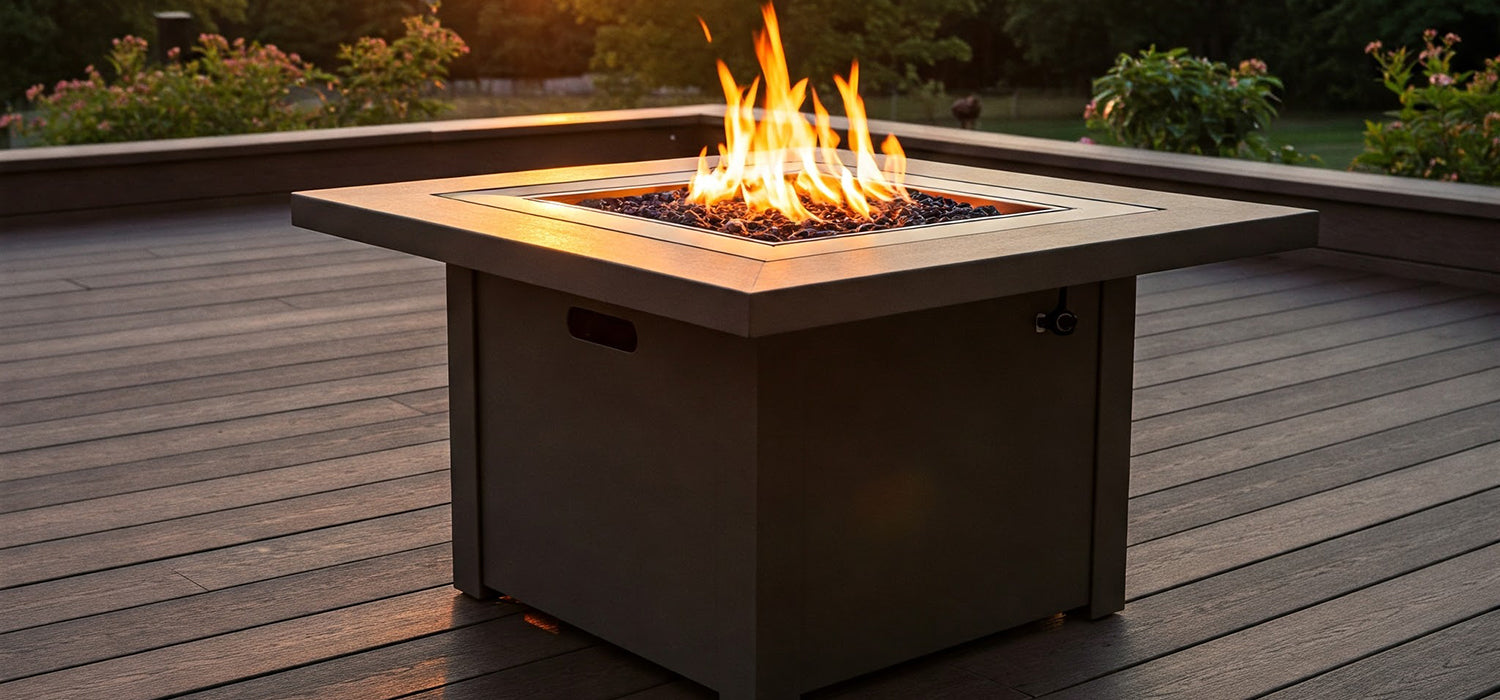
Are Fire Tables Warm Enough? A Complete Guide to Heat Output
So, are fire tables warm enough to keep you cozy on a chilly evening? Short answer: yes, but with a catch! While fire tables offer snug warmth for small gatherings, they’re not built to heat an entire backyard. Keep reading to find out how to make the most of yours!
Heat Output and Coverage
BTU Rating:
Understanding BTU and Heat Output
When shopping for a fire table, you’ll often see the term BTU (British Thermal Units) thrown around. But what does it mean for your comfort? Simply put, BTUs measure the amount of heat a fire table can produce. Most gas fire tables churn out between 30,000 and 50,000 BTUs—enough to keep you comfortable on a cooler evening, but not quite the same as a roaring bonfire. If you’re expecting to heat your whole garden, you might want to look elsewhere, but for small, intimate gatherings, this is perfect.
Choosing the Right BTU for Your Space
Choosing the right BTU for your space depends on how big your outdoor area is and how many people you want to keep warm. If you’re hosting a small get-together on your balcony or a cosy patio, a table with 30,000 BTUs should do the trick. However, if you're aiming to heat a larger space, you’ll want to opt for a higher rating. Just bear in mind that even the highest BTU fire tables will only heat the area directly around them—so, no, they won’t turn your entire backyard into a sauna.
Flame Height and Adjustment:
Adjusting Flame for Desired Warmth
One of the biggest perks of fire tables is the adjustable flame. On those colder evenings, you can simply turn the dial and ramp up the flame to get that extra warmth. It’s quick and easy, and you’ll feel the difference instantly. If you’re sitting close to the table, the heat should be plenty to keep you comfortable, even as the temperature drops.
Consistent Heat Distribution
However, it’s important to remember that fire tables distribute heat differently than traditional fire pits. The warmth is most concentrated around the flame, and the further you move away, the cooler it gets. Unlike a bonfire or larger fire pit that sends heat in all directions, gas fire tables are more about localized warmth. So, if you’re sitting around the table, you’ll be fine, but anyone further away might need a blanket!
Factors Affecting Warmth
Size and Shape of the Table:
Larger Tables Provide More Heat
As with most things in life, bigger is better—at least when it comes to fire tables. Larger tables typically provide more surface area, meaning more heat can be distributed across a wider space. If you have a small table, the heat will be more concentrated, making it perfect for an intimate gathering. But if you’re looking to keep a few more people warm, a larger table will do the job much better.
Shape Affects Heat Distribution
The shape of your fire table also plays a role in how the heat is spread. Round tables tend to provide a more even distribution of heat, while rectangular tables may focus the warmth more narrowly. If you’re hosting a big group, a round table could be the better option, as it allows everyone to gather around the fire and feel the warmth.
Fuel Type and Gas Flow:
Propane vs. Natural Gas
The type of gas your fire table uses—propane or natural gas—makes a difference in both warmth and convenience. Propane is portable, meaning you can move your fire table around, but it’s not as consistent as natural gas, which is more reliable and can provide a steady heat source if connected to your home’s gas line. For smaller spaces and more mobility, propane is ideal. But for those looking for continuous warmth, natural gas is the way to go.
Ensuring Proper Gas Flow
To make sure your fire table is working at full capacity, it’s essential to ensure a consistent gas flow. No matter which fuel type you choose, any obstruction in the gas line or tank can result in a lack of heat. Always check for leaks, ensure the tank is full, and keep an eye on the gas regulator. This will guarantee your fire table stays reliable when you need it most.
Weather Conditions:
Wind and Temperature Affecting Heat
We’ve all been there—sitting around a fire table on a breezy evening, only to feel the heat blown away by the wind. Unfortunately, wind can really take the edge off the warmth produced by a fire table. In fact, the colder the temperature and the stronger the wind, the less effective the heat will be. But don’t worry; this isn’t a deal-breaker. There are ways to still enjoy the warmth.
Using Wind Guards or Shields
A simple solution to the wind problem is investing in a wind guard or shield. These handy additions help block the wind and keep the heat concentrated around the table. Many fire tables come with these accessories, but if not, they’re easy to add and really make a difference when the weather’s not on your side.
Safety Considerations
Maintaining a Safe Distance:
Avoiding Direct Contact with Flames
It might seem obvious, but it's essential to remember that fire tables are still, well, fire! Always maintain a safe distance from the flames. Sitting too close can result in burns or discomfort, so be mindful of how near you are to the heat source. It’s a good idea to set a clear boundary to ensure everyone stays safe while still enjoying the warmth.
Protecting Surfaces from Heat
Fire tables can also damage surfaces beneath them due to the intense heat they generate. If you’re placing your table on a wooden deck or other heat-sensitive surface, consider using a heat-resistant mat underneath. This simple measure will protect your outdoor spaces and ensure your fire table continues to serve you for years to come.
Tips for Maximizing Warmth
Using Wind Guards or Shields:
Blocking Wind to Retain Heat
To get the most out of your fire table, especially on gusty days, wind guards are a must. These handy shields block the wind and keep the heat from escaping. They’re often included with the table, but if not, you can easily find a variety of options that will work with most models. The key is to stop the wind from blowing away your hard-earned warmth.
Adjusting Flame Height:
Increasing Flame for More Warmth
If you’re feeling the cold and want more warmth, adjust the flame height! Many fire tables let you do this with a simple turn of a knob or press of a button. Increasing the flame will provide more heat, so feel free to turn it up when the temperature drops. Just make sure to follow the manufacturer's guidelines to keep everything safe and secure.
Conclusion
Fire tables are a brilliant way to add warmth and ambience to your outdoor space, but they come with a few limitations. While they provide excellent heat for small gatherings, they’re not the best option if you’re looking to heat your entire garden. By understanding factors like BTU rating, the size and shape of the table, fuel type, and the weather, you can make sure you get the most warmth possible. And don’t forget those handy tips for maximising heat, like using wind guards and adjusting the flame height. With the right approach, your fire table will be a cosy, stylish addition to your outdoor space for years to come!
Other content we think you'll love
- Gas Fire Pit for S’mores: Your Guide to Gooey Backyard Treats
- Can You Use a Fire Pit When It’s Windy? (Yes—Here’s How to Stay Safe and Cosy)
- The Ultimate Guide to Choosing a Tabletop Gas Fire Pit
- Gas Fire Pit for Small Patios: The Perfect Solution for Cosy Outdoor Vibes
- Gas Fire Pit for Covered Porch: Enjoy Cozy Warmth All Year Round
- Gas Fire Pit for RV: Your Cosy Companion on the Road
- The Best Portable Gas Fire Pit for Motorhome Camping: A Complete Guide
- The Ultimate Guide to Choosing a Gas Fire Pit for Camping
- Choosing the Perfect Gas Fire Pit for Your Garden
- Are Fire Pit Dining Tables Worth It?
- The Ultimate Guide to Cooking on a Gas Fire Pit
- Are Fire Tables Worth It? Here's What You Need to Know Before Buying
- The Ultimate Guide to Popcorn Making with a Fire Table
- Can You Roast Marshmallows Over a Gas Fire Pit?
- Are Gas Fire Pit Tables Any Good? A Full Guide to Cosy Outdoor Living
- When to Use a Fire Pit: Timing is Everything!

